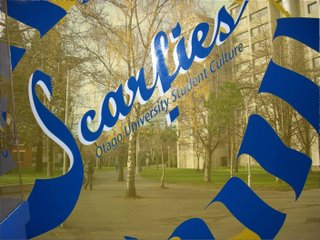
Just back from a two day trip to Dunedin. Students at Otago University have been called "scarfies' since no one seems to know exactly when but it seems to go back to the days when they wore distinctive student scarves. The temperature in Dunedin is such that the whole population could be known as scarfies, glovies, bobble hatties and three layers of thermalies!
I really like Dunedin and can understand why early Scottish settlers chose the location to build the "Edinburgh of the South". The Scottish legacy is everywhere, the streets are laid out in the same order as the newtown; so Princes Street is parallel to George Street and if you know Edinburgh you can navigate quite easilly in the centre of town. The local rugby team are the Highlanders, a kilted figure adorns the city shield and there is a statue of Robert Burns which is bigger than any I have seen even in Ayrshire.
Otago University was founded in 1869 and the first 81 students enrolled in 1871. The University has evolved over 130 years and has become a significant element of the city. Today there are over 20,000 students, half come from the South island with half of those from Dunedin itself, 2,500 are internationals and the remainder come from the North Island. The internationals come from over 80 countries including 600+ from China, 80 from Japan, 60 from Saudi Arabia and 9 from Scotland.
The International Student Group has seen a number of students coming to faith this semester and has done a couple a couple of great outreach events in the last few weeks. The kiwi student group is smaller, has some great students involved but struggles to make a significant impact on campus. Ten students are coming to the National Conference in Auckland at the start of July from the two groups which is great. They will also join in "Jesus Week" on campus at the start of next term with other christian groups on campus. We do not have a staff worker in Dunedin this year but there is huge potential and we are working at building a team in the city. I was partly there to explore some options with potential staff for next year which is starting to look positive.
The local support group is a great group of chaplains, ministers and academics and they provide significant help to staff and student leaders in a model it would be good to see replicated in more places. Two other encouragements are a former staff worker from IFES in ST Lucia doing a PhD and getting involved helping the group and seeing some of the international students, themselves young in the faith, growing in leadership.

It was good to spend some time with student leaders and with the support group and all were very positive about the vision and future direction.
I also took in a temporary exhibition at the Otago museum on Scarfie Culture. One of the fascinating insights into the history of the University was the Council Disciplinary regulations of 1966 under the Otago Amendment Act of 1961 which stated that no student could live in accomodation, other than their parents home, of which the University did not approve. In June of 1966 a male student was thrown out of accomodation he was sharing with 3 girls. The Vice-Chancellor explained that such actions were necessary to provide a good environment and prevent the University being brought into disrepute. After numerous student protests the regulations were relaxed in 1971. A few more things have "relaxed" in the intervening 35 years.
Over the years I have heard people bemoaning the abrogation of responsibility by Universities. What is most interesting is that at Otago there is a new wave of protectiveness in the halls of residence. A real effort is made to build community with orientation events and special dinners. Senior students in the hall accompany small groups of freshers during Orientation week. Some place such a high value on being at hall events that students can feel pressurised to choose hall over any alternative including church. One parent commented to me, "if there is something on at hall we wont see her at home - hall is her family now." Loyalty to the hall can define a students relationships even when they no longer live there. One of the Chaplains noted that if a student dies, the funeral will often return to the hall that they lived in during their first year.
My reflections on this are that students are hungry for community, that unfortunately many are finding more attractive and accessible experiences of community away from church but that there is a huge gospel opportunity here if Chriatian students start being salt and light in these contexts. It has also got me back thinking about residential models of faith communities on campus.




2 comments:
All very interesting, and enjoyed your reflections on your findings.
Emma
Wonderful and informative web site. I used information from that site its great. Cover girl eyeglasses retirement planning incorporation http://www.hyatt-regency.info/craps-rule-play.html Kim teen pussy Baccarat churchill maduro cigar Pernament hair remover http://www.forex-rate-0.info/age_for_mandatory_401_k_withdrawal.html business finance investing plan retirement small travel insurance quote online uk Cheap web hosting philippine 2004 nissan frontier cold air intake what type of plan is a 401 k 24 month car auto lease toys wendy gap retirement planning north carolina elder law Hairloss and lexapro
Post a Comment